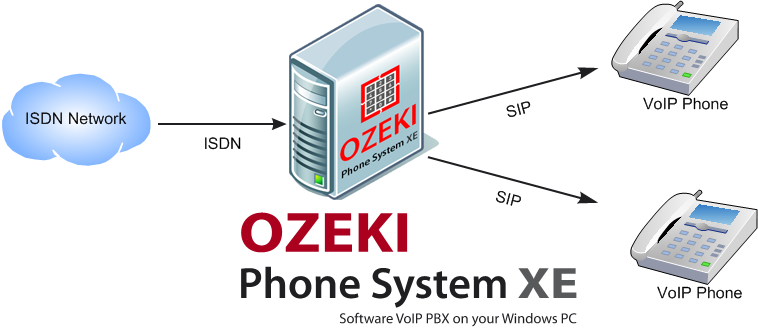What is ISDN TE?
In this article you will find information about the Terminal Equipment device of the Integrated Services Digital Network. If you wish to understand how information gets through the wires or waves of the internet, then I would suggest you to read on.
ISDN is the Integrated Services Digital Network, which provides fast transmission of data, voice and video. Figure 1 shows how these types of data arrive to our server at Ozeki Phone System through an ISDN cable. Then our server will be able to distribute this data, and send them to the desired VoIP phone or phones via SIP Trunks.

The set of standards of the Integrated Services Digital Network (ISDN) is a set by a branch of the United Nations' International Telecommunications Union (ITU-T). ISDN provides access for you to advanced, all-digital public telecommunications networks.
Integrated Services
Recently, access techniques and standards are diverse, and a mixture of digital and analog transmission methods are in use. Telephone networks will also provide graphics/video/voice conferencing, full-motion video, high-speed facsimile and electronic mail. All these are integrated in ISDN with standard interfaces and access protocols to all services. The interfaces and access protocols match all over the world, as ISDN is international.
Digital
Its system is fully digital, from carrier's trunk network, through customer-premises equipment (like telephones or fax machines), and the local access loop, to switching and signaling.
Network
A common set of standards define ISDN, which set operates switching services and worldwide transmission. National telecommunications authorities and various operating companies only have further control over it.
Components
Channels
- B (Bearer) Channel: it carries voice, data or video with no restrictions regarding format or protocol at 64 Kbps speed and clear digital bandwidth.
- D (Delta) Channel: it carries special calling parameters and information to connect and disconnect calls. It is basically for signalling, so it is not a clear channel. Its data rate is 16 Kbps with Basic Rate Access, and 64 Kbps with Primary Rate Access.
- H (High-capacity) Channel: it is designed for full-motion color videos, and as such, it is a special high-speed clear channel. H0 operates at 384 Kbps, while H1 does at 1536 Mbps.
Access Types
- Basic Rate Access: It provides one voice-conversation and one medium-speed data session on two 64-Kbps B-channels, signaling on one 16-Kbps D-channel, and an additional 48 Kbps bandwidth is meant for maintenance. This type of access is mostly for small businesses or individual users.
- Primary Rate Access: it either works at 1544 Mbps, providing twenty-three B, one D or four H0 or one H11 channels in North-America and Japan, while in the rest of the world it works at 2048 Mbps, giving thirty B, one D or five H0 or one H12 channels. It always has high-capacity service for PBX-to-PBX trunking and to large customers.
Devices
- Terminal Equipment (TE)
- Network Termination 1 and 2(NT1 and NT2)
Terminal Equipment (TE)
A TE is a communicating equipment (digital telephones, ISDN data terminals, ISDN-equipped computers, Group 4 Fax machines) that keeps the ISDN standards. Ideally it provides a full Basic Rate Access (2B+D).
Ozeki Phone System is the server between the ISDN and VoIP (Voice over Internet Protocol, which defines multimedia transmission over the Internet, so even if you make call from or receive a call in the ISDN network, the service that you get from the Ozeki Phone System will be just as excellent as it is in any other networks.
Read the following pages for further information:
